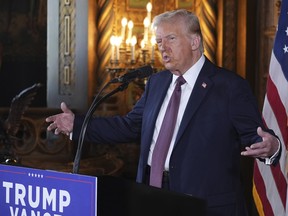U.S. President-elect Donald Trump has sharpened his rhetoric on Canada, portraying the neighbor to the north as a potential new member of the United States under terms that would be driven by economic force rather than military action. Speaking at a press conference at his Mar-a-Lago resort in Florida, he reiterated plans to impose “substantial” tariffs on goods from Canada and Mexico, framing the move as a pragmatic means to redraw the continent’s economic architecture. He asserted that removing the artificially drawn border line would, in his view, produce a clearer, more secure arrangement for both nations. The remarks presented a stark departure from posturing that had previously left many observers uncertain about Trump’s ultimate approach to cross-border relations. This article examines the statements, the economic rationale behind them, and the broader implications for Canada, the United States, and their intertwined economies.
The Mar-a-Lago remarks and the proposed strategy of “economic force”
Trump’s comments at Mar-a-Lago underscored a deliberate pivot away from talk of military annexation toward a focus on economic leverage. When pressed about the possibility of using military force to annex Canada, he answered in the negative, signaling instead that any expansion would be achieved through economic tools. He emphasized that the United States could look at Canada’s border and its integrated markets “through a different lens,” suggesting that rethinking the border could yield benefits for national security and for the United States’ own industrial base. The emphasis on economic force reflects a belief that tariffs and other trade measures could compel Canada to concede to a new, more favorable framework for U.S. interests.
In this framing, the concept of a border reconfiguration becomes a question of recalibrating who profits from the deepest arteries of North American trade. The argument rests on a narrative that a border that resembles the current, artificially drawn line may constrain national security just as it constrains economic efficiency. Trump’s portrayal of economic force positions tariffs as the primary instrument to extract concessions from Canada and Mexico, potentially altering how supply chains are organized across North America. The remarks indicate a strategy that prioritizes negotiable, tariff-based leverage over unilateral declarations of political status or emergency actions. Such an approach would require careful consideration of trade-law implications, the likely retaliation from Canada, and the long-term effects on regional integration.
A central element of Trump’s line of argument is his assertion that the United States is subsidizing Canada substantially. He claimed that U.S. subsidies to Canada total roughly US$200 billion per year, a statement that appears to reference the broader dynamics of the U.S. trade deficit with Canada and other factors that influence the bottom line for both economies. In this framing, the cost of maintaining a robust North American market seems to be disproportionately borne by the United States, thereby justifying a corrective policy of tariffs aimed at recalibrating bilateral flows. While the figure cited is high and open to interpretation, what matters for policy is the perception of imbalance and the potential to use tariff policy to alter that balance in a way that Trump argues would benefit the United States.
The official data on bilateral trade provides context for these claims. The total U.S. trade deficit in goods and services with Canada was about US$40.6 billion in 2023, according to U.S. Census Bureau data. This deficit is heavily influenced by energy trade, as the United States has long imported substantial volumes of Canadian crude oil. In some months, the United States purchases more than four million barrels per day of Canadian crude, underscoring how energy flows anchor the bilateral relationship. Any tariff strategy would thus have immediate and pronounced effects on energy markets, refinery configurations, and broader North American energy security calculations. The magnitude of energy interdependence makes the economic force argument particularly consequential for policy planners on both sides of the border.
Trump’s rhetoric also touched on national security considerations associated with a closer integration of Canada into the United States’ strategic perimeter. He argued that eliminating the border’s traditional, legally defined lines could reveal a more coherent, security-oriented arrangement. The claim implies a belief that tighter economic alignment—through tariff adjustments, investment policies, and regulatory alignment—could yield enhanced national security outcomes. Critics would point to the potential risks of destabilizing long-standing cross-border supply chains and complicating a tightly interwoven energy and manufacturing ecosystem. Supporters, however, might argue that a more unified economic bloc could strengthen resilience and reduce vulnerabilities in the face of external shocks.
Beyond the tariff posture, Trump’s remarks also touched on broader economic narratives, including the idea that there is a lack of necessity for certain Canadian-produced goods within the United States’ domestic market. He stated that the United States does not need “anything” that Canada produces, a line intended to underscore the possibility of reshaping trade reliance. He also indicated a preference for domestic production, suggesting a shift toward U.S.-based manufacturing—illustrated by his emphasis on Detroit as a production hub for vehicles rather than a heavy reliance on cross-border supply chains. In discussing the lumber market, he suggested that an executive order to “un-restrict” it could promote domestic supply, signaling a willingness to employ executive actions to reorient resource use and capacity toward American interests.
The discussion at Mar-a-Lago occurred against a backdrop of longstanding cross-border collaboration and shared economic stakes. Canada remains a primary supplier of critical resources to the United States. In particular, Canada is the largest external supplier of oil to the United States, and its uranium is the biggest foreign source of fuel for U.S. nuclear power plants. Potash, too, is a major fertilizer input for American agriculture. Any attempt to disrupt or transform these supply channels would reverberate through energy markets, industrial sectors, and agricultural economies across North America. The cross-border dependencies create a complex calculus for policymakers: unilateral tariff moves could yield retaliation, price volatility, and shifts in investment that might either stabilize or destabilize regional economic fundamentals, depending on how measures are sequenced and enforced.
In sum, the Mar-a-Lago remarks framed Canada’s potential status as a political and economic objective rooted in the leverage of tariffs and supply-chain reorientation. The proposed approach emphasizes economic force as the primary instrument, while explicitly rejecting overt military annexation. The statements highlighted a broader question about how a future United States might recalibrate its relationship with Canada and Mexico to reflect a new balance of economic power, industrial capability, and national security priorities. The ensuing discussions would need to address legal, political, and geopolitical complexities, including how to manage trade disputes, how to implement tariffs in a manner consistent with international trade rules, and how to preserve the integrity and resilience of integrated North American markets.
The bilateral trade context: deficits, energy, and price signals
To understand the potential impact of Trump’s tariff propositions, it is essential to examine the core trade dynamics between the United States and Canada, especially in energy and high-value materials. The United States has long benefited from access to Canada’s abundant natural resources, with energy products forming a substantial portion of the bilateral trade relationship. The energy dimension is central to any tariff conversation, because it anchors the structural interdependencies between the two economies and helps explain why policy moves can produce rapid and significant market reactions.
The United States’ trade deficit with Canada is often viewed through the lens of energy imports and related commodities. In 2023, the bilateral deficit stood at US$40.6 billion, illustrating a broad imbalance that exists even while other sectors show surplus or balanced flows. A significant portion of this deficit is tied to crude oil and refined products, reflecting how the United States depends on Canada for energy inputs that feed gasoline, diesel, and industrial processes across the economy. The sheer volume of Canadian crude oil that has flowed into U.S. markets during certain periods—more than four million barrels per day in some months—illustrates how deeply the energy trade anchors the bilateral relationship. Tariff policies that disrupt or alter this dynamic would likely ripple across refining margins, transportation costs, and energy prices for consumers and businesses.
From a macroeconomic standpoint, the possibility that the United States subsidizes Canada by as much as US$200 billion per year is a provocative figure. If interpreted as the broader net effect of trade balances, subsidies, and administrative support that benefits Canada through favorable market conditions or policy alignments, such a claim could be seen as a political shorthand for arguing that Canada enjoys advantages within a highly integrated market. Regardless of the exact accounting, the underlying idea is that the United States bears a disproportionate burden in maintaining North American economic activity, which Trump argues justifies recourse to tariffs or other corrective measures. Critics counter that tariffs tend to raise costs for American consumers and businesses, distort investment, and invite retaliatory actions that could erode the very gains that come from cross-border cooperation. The real-world consequences hinge on tariff design, scope, and the duration of any such measures.
The energy sector’s central role means any policy changes would have immediate market consequences. If tariffs were employed as a tool to recalibrate trade flows, energy trading patterns could shift as producers and refiners reassess supply sources and cost structures. Canadian energy exporters could seek alternative markets or adjust pricing strategies to preserve revenue, while American refiners would need to source capacity from other suppliers or invest in domestic capacity expansions. Such shifts could affect consumer energy prices, industrial energy costs, and the competitiveness of energy-intensive sectors across North America. The broader economic ripple effects would extend to employment in energy infrastructure, refining, and related manufacturing, as well as to investment decisions in exploration and production within Canada.
In a broader sense, the tariff debate intersects with questions about regulatory alignment and industrial policy. Tariffs are only one instrument in a toolkit that includes trade rules, anti-dumping measures, and rules-of-origin standards that determine how much value must be sourced domestically to qualify for preferential treatment. A North American policy posture that seeks to expand U.S. manufacturing, reduce reliance on foreign suppliers, or restructure cross-border value chains would need to consider a wide array of tools beyond simple tariff imposition. The consequences would cascade through supplier networks, shipping routes, and regional labor markets, altering competitive dynamics for years to come. The challenge for policymakers is to design measures that achieve strategic goals without destabilizing the deeply integrated economy that North America has become.
Meanwhile, Canadian policymakers are watching these developments closely and evaluating their own options. Officials in Ottawa have reportedly considered the potential use of export taxes on certain key commodities—such as uranium, oil, and potash—as countermeasures in the event of a trade war. This approach would represent a strategic attempt to preserve Canada’s economic leverage and ensure continued access to U.S. markets while signaling that Canada would respond firmly to any tariff on its exports. The policy toolbox in Canada would thus expand beyond traditional diplomacy and economic outreach to include more assertive tax-based instruments that can influence the direction and pace of bilateral trade. The net effect of such measures would likely be to heighten the complexity of negotiations and to introduce new costs and uncertainties for businesses operating across the border.
The currency market movement provides another lens through which to view the evolving bilateral dynamic. Following Trump’s tariff threats, the Canadian dollar experienced downward pressure relative to the U.S. dollar. The loonie declined modestly, with reports noting a dip to around C$1.4344 per U.S. dollar in intraday trading at one point. Currency movements reflect investor expectations about how tariffs or trade disruptions could alter cross-border investment, capital flows, and inflation dynamics. A weaker Canadian currency can have mixed consequences: it may help Canadian exporters by making their products cheaper for U.S. buyers, but it can also raise the cost of imported goods and fuel higher costs for Canadian consumers. The net effect will depend on the structure and duration of any tariff regime, as well as the resilience of supply chains and the degree of policy coordination between Ottawa and Washington.
On the political front, Canada faces a delicate balancing act as it navigates a potential shift in bilateral trade dynamics. Prime Minister Justin Trudeau and his government have to weigh national economic interests, political optics, and public sentiment. A prominent public reaction came in the form of a tweet by Trudeau that dismissed the likelihood of Canada ever becoming part of the United States, emphasizing that there is “not a snowball’s chance in hell” that Canada would be subsumed. The public response among Canadians appears largely resistant to the idea, with polls indicating strong opposition to any form of political absorption into the United States. This domestic sentiment adds a layer of pressure on Trudeau and his government to articulate a clear and measured response that protects national autonomy while also maintaining a functional and cooperative cross-border relationship.
Economically, the broader stakes involve critical Canadian commodities—the country’s role as a leading energy exporter, the significance of uranium for U.S. nuclear power plants, and the importance of potash for American agriculture. The U.S. reliance on Canada for these core inputs means any policy leverage in Washington would have to account for how those supplies would be replaced or substituted in the event of disruption. The cross-border energy and resource nexus underpins the risk that tariff measures could produce unintended consequences, including price volatility, supply chain instability, and longer-term shifts in investment patterns. The potential for a trade dispute to escalate into a broader strategic realignment adds a layer of geopolitical complexity that goes well beyond immediate tariff economics.
In this context, Canadian leadership is recalibrating its message and strategy. Foreign Minister Mélanie Joly has publicly stated that Canada will not yield to threats and will defend its interests, signaling resolve in the face of pressure to concede. At the same time, political dynamics within Canada are shifting. The Conservative Party leadership, led by Pierre Poilievre, has asserted that Canada would never become a U.S. state, a position reflected in public statements and campaign rhetoric. The evolving political landscape in Canada—alongside the internal dynamics of Trudeau’s Liberal government—adds to the uncertainty about how cross-border negotiations might unfold or whether a domestic political settlement could temper any aggressive tariff posture from the United States. In the broader parliamentary context, these developments complicate the ability of both governments to craft a coherent, long-term strategy that preserves economic vitality while respecting national sovereignty and democratic norms.
Reactions, resilience, and the path forward for North American ties
The reaction to Trump’s remarks spanned political actors, markets, and public opinion, illustrating the fragility and potential fragility of cross-border cooperation in a high-visibility policy moment. Within Canada, questions about national identity, sovereignty, and the enduring value of bilateral cooperation emerged as central themes. The public mood, as captured by polling data indicating strong opposition to Canada’s annexation, suggests that policymakers face a challenging political terrain if they were to entertain significant policy shifts in response to tariff threats. Ottawa’s approach appears to prioritize resilience—preserving energy trade, safeguarding strategic industries, and maintaining favorable access to American markets—while signaling readiness to respond with targeted measures if unilateral moves threaten Canada’s interests.
In Washington, the policy debate centers on the appropriate use of tariffs as a tool of negotiation, the potential fallout from retaliatory actions, and the long-term impact on North American competitiveness. Proponents of a robust tariff strategy argue that tariffs can be a lever to secure more favorable terms for domestic industries, to correct perceived imbalances in trade, and to strengthen national economic sovereignty. Critics warn that tariff policy risks escalating into a tit-for-tat cycle, raising consumer prices, complicating relationships with allies, and undermining the integrated supply chains that underpin American manufacturing. The political calculus in the United States must consider the domestic costs of tariff exposure on consumers and businesses, particularly in sectors that rely heavily on U.S.-Canada cross-border inputs and markets.
The broader economic implications extend into investment decisions, corporate strategies, and regional development plans. Multinational companies operating across North America must weigh their exposure to tariff policies, regulatory alignments, and potential changes in cross-border logistics. Energy firms, mining companies, and producers of critical materials like potash and uranium would face a new set of risk factors that could alter project timelines, capital allocation, and long-term planning. Financial markets would respond not only to the tariff announcements themselves but also to the expectations about how long such measures would persist and what remedies exist within the framework of international trade law. In this environment, the interplay between policy signaling, private sector adaptation, and public sentiment will determine whether North American economic integration remains durable or undergoes a recalibration under new political leadership.
As the political calendar progressed, leadership transitions within Canada and shifts in U.S. policy emphasis could alter the trajectory of any tariff-based strategy. Trudeau’s government—facing internal party dynamics and the public’s preference for stability—had already signaled a readiness to respond decisively to perceived threats while continuing to advocate for a strong, working relationship with the United States. The resignation announcement added a layer of uncertainty regarding Canada’s immediate policy direction, yet the core economic ties remained intact, continuing to rely on cross-border commerce and energy flows. In the United States, the political narrative around tariffs and the possibility of altering or dissolving the current North American economic arrangement was closely tied to broader debates about manufacturing, energy independence, and national security. These debates are likely to shape a policy environment in which any tariff measures are evaluated not only on their immediate economic outcomes but also on their strategic implications for North American cohesion.
The cross-border public discourse, while intensely focused on political leadership, also reflected a growing recognition among citizens and businesses of how deeply bound Canada and the United States have become. The shared infrastructure, labor markets, and investment ecosystems create mutual dependencies that complicate the prospect of simple policy reversals. Public sentiment, political calculations, and the risk of escalating trade disputes all factor into how policymakers in both countries might approach the question of whether to pursue tariffs, export taxes, or other measures as a means of achieving strategic goals. In this sense, the Trump administration’s rhetoric functions as a test case for how resilient the North American economic order is in the face of provocative policy proposals and how adaptable the two governments are in responding to shifting public expectations, pressing economic needs, and ongoing geopolitical uncertainties.
Conclusion
The exchange around Canada’s potential status within a reimagined United States underscores the enduring complexity of cross-border relations in North America. Trump’s insistence on using “economic force” rather than military action to pursue a major realignment of the continent’s political-economic landscape highlights a strategic approach that hinges on tariffs, energy trade, and regulatory alignment. The claim of substantial subsidies to Canada, the bilateral deficit figures, and the central role of energy imports all contribute to a nuanced picture of why any tariff-based strategy would be consequential for both countries. Canada’s position remains anchored in safeguarding sovereignty while navigating the realities of an integrated economy with the United States, a relationship that has long defined North American prosperity. The political reactions, poll data, currency movements, and policy deliberations that followed reflect the high stakes involved in negotiating any shift away from the traditional bilateral equilibrium.
As the situation evolves, the path forward will likely involve a combination of calibrated policy instruments, careful market management, and sustained diplomatic engagement. Ottawa’s potential use of export taxes, the balance between domestic industries and consumer costs in the United States, and the resilience of cross-border supply chains will all be tested in the coming months. The broader question is whether North American leaders can preserve a cooperative framework that supports economic growth, national security, and regional stability while addressing concerns about fairness, sovereignty, and strategic autonomy. The ultimate outcome will depend on how policymakers translate provocative rhetoric into practical policy that respects the mutual interests of both nations and reinforces the enduring bonds that have defined Canada-U.S. relations for generations.




